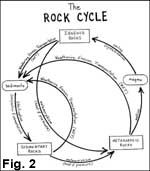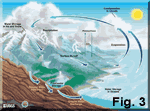Home | Session 3 | Earth Science in a Nutshell
Earth Science in a Nutshell
Earth processes (include destructive and constructive) - act on and transform Earth materials. The processes are more important than the materials. All processes and materials are interconnected and are brought together through various cycles, described below.
What forces (energy sources, flow) drive these cyclic, interactive processes and systems?
-
Plate Tectonic cycle - (See Fig. 1 below, click to zoom in)
 This
is the ultimate recycling of the earth's materials through plate motions,
mantle convection, subduction, spreading ridges, volcanoes, earthquakes,
mountain building, etc. The source of energy to drive plate tectonics
is from latent heat of formation and radioactive decay. These release
energy, which is transferred by convection currents.
This
is the ultimate recycling of the earth's materials through plate motions,
mantle convection, subduction, spreading ridges, volcanoes, earthquakes,
mountain building, etc. The source of energy to drive plate tectonics
is from latent heat of formation and radioactive decay. These release
energy, which is transferred by convection currents. - Rock cycle - (See
Fig. 2, click to zoom in)
 There
are three processes that form rocks: igneous, metamorphic, and sedimentary
processes. Any rock can become any type of other rock. The source of
energy for the rock cycle is both internal (convection currents, see
the plate tectonic cycle above) and external (the sun).
There
are three processes that form rocks: igneous, metamorphic, and sedimentary
processes. Any rock can become any type of other rock. The source of
energy for the rock cycle is both internal (convection currents, see
the plate tectonic cycle above) and external (the sun).
Igneous (Ig = fire): A process of melting and cooling. Once on the surface, igneous rocks weather, break down, and erode to form silt, sand, sediment, soil etc. All of these can be "glued" back together into sedimentary rock. Sedimentary rock can become igneous rock without going through a metamorphic stage. Metamorphic rocks are baked and changed, but not melted.
Look back at the Plate Tectonic cycle (Figure 1, above). Where would you find the formation of igneous rocks? In mid-ocean ridges and spreading centers, volcanoes and hot spots. Where would you find the formation of sedimentary rocks? On the ocean floor (carried by rivers) and on the surface of the earth. Where would you find the processes to form metamorphic rocks? In subduction zones and areas of mountain-building.
- Water Cycle - (See
Fig. 3, click to zoom in)
 The
sun is the source of energy that drives this cycle. The products (shown
in Figure 3) are rain, fog, clouds, water, glaciers, snow, ocean, and
streams. The processes are condensation, precipitation, evaporation
and transpiration.
The
sun is the source of energy that drives this cycle. The products (shown
in Figure 3) are rain, fog, clouds, water, glaciers, snow, ocean, and
streams. The processes are condensation, precipitation, evaporation
and transpiration.
The rock cycle and water cycle overlap with erosion, transporting, and deposition.
-
Carbon Cycle - (See Figs 4 and 5 below, click to zoom in)

 This
is where the life cycle interacts with the rock cycle. Life decomposes
and releases carbon back into the soil, which eventually becomes sedimentary
rock. Burning fossil fuel also releases carbon (in the form of CO2)
into the atmosphere. There is a lot of CO2 trapped in rocks such as
limestones. Their weathering also releases CO2 into the atmosphere.
This
is where the life cycle interacts with the rock cycle. Life decomposes
and releases carbon back into the soil, which eventually becomes sedimentary
rock. Burning fossil fuel also releases carbon (in the form of CO2)
into the atmosphere. There is a lot of CO2 trapped in rocks such as
limestones. Their weathering also releases CO2 into the atmosphere.
The short-term carbon cycle describes plant and animal respiration. The long-term carbon cycle is determined by plate tectonics.
updated February 11, 2002
UCMP Home | What's new | About UCMP | History of Life | Collections | Subway